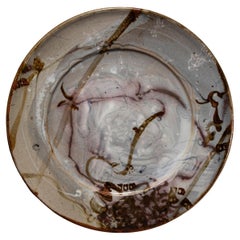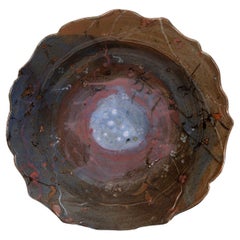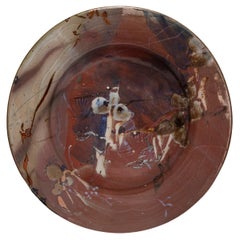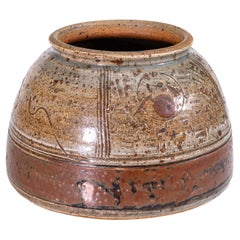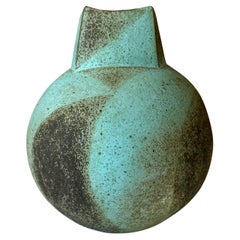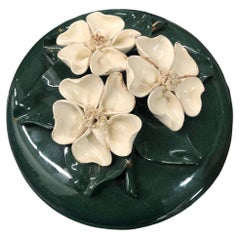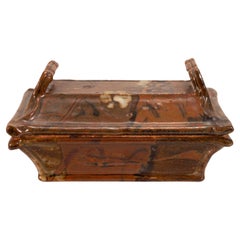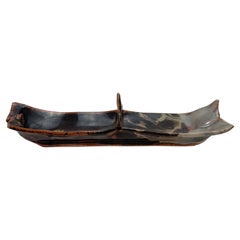John Glick Furniture
to
1
23
23
1
1
1
23
2
20
1
4
23
10
2
22
22
23
23
23
12
7,546
3,967
2,548
2,244
Creator: John Glick
John Glick Plum Street Pottery Ceramic Charger Monumental
By John Glick
Located in Bloomfield Hills, MI
The ceramic charger is an example of the kind of work by which John Glick became so famous. He was seduced by the effects of the reduction kiln, which decreased the levels of oxygen during firing, inducing the flame to pull oxygen out of the clay and glazes changing the colors of the glazes depending on their iron and copper content. In this way he achieved the rich gradients of ochre and umber and variations in stippling and opacity. It is signed by the artist and stamped with Plum Street Pottery #129 on the verso.
John was an American Abstract Expressionist ceramicist born in Detroit, MI. Though open to artistic experimentation, Glick was most influenced by the styles and aesthetics of Asian pottery—an inspiration that shows in his use of decorative patterns and glaze choices. He has said that he is attracted to simplicity, as well as complexity: my work continually reflects my re-examination that these two poles can coexist… or not, in a given series. Glick also took influences from master potters of Japan, notably Shoji Hamada and Kanjrio Kawai, blending their gestural embellishments of simple forms with attitudes of Abstract Expressionism. He was particularly drown to the work of Helen Frankenthaler whose soak-stain style resonated with Glick’s multi-layered glaze surfaces, which juxtaposed veils of atmospheric color with gestural marks and pattern. He spent countless hours developing and making his own tools in order to achieve previously unseen results in his work with clay and glaze.
Glick’s “Plum Tree Pottery” (now a designated historic landmark in Farmington Hills, Michigan) studio opened around 1965 and closed in the summer of 2016. It was a private studio space for John and a number of his students and assistants. He believed his shapes evolved guided by forces apparently outside his control. This was instinctual, intellectual and due to his openness to change, fusing into what he thought was the most positive force behind a potter’s approach: evolution and growth. Some have called it inspiration.
John was not only a major figure in the Detroit creative community, but in the ceramics world at large. According to Shelley Selim in her book on John, “John Glick: A Legacy in Clay” John remains: “one of the most recognizable names in the field of studio pottery – known for lecturing, publishing, and offering workshops widely – and his work has been featured in well over a hundred local, national and international exhibitions since he was a college student in the late 1950s.” Along with this John has mentored over thirty studio apprentices over five and a half decades, received numerous grants and awards for his work, and has been prolific, with an estimated 300,000 ceramic wares throughout the world.
He received his Masters from Cranbrook Academy of Art in Bloomfield Hills, Michigan, working with Maija Grotell, a legendary and influential teacher. Grotell was noted for her deep interest in the human connection to nature’s rhythms and patters. These ideas often grounded her dialog with her students including Glick, affecting, a profund and lasting influence on his future work. This famous Art Academy was designed by architect and faculty member, Eliel Saarinen who collaborated with Charles and Ray Eames on chair and furniture design. Numerous creative artists who are alumni of Cranbrook include: Harry Bertoia, Florence Knoll, Jack Lenor Larsen, Donald Lipski, Duane Hanson, Nick Cave, Hani Rashid, George Nelson, Urban Jupena (Nationally recognized fiber artist), Artis Lane (the first African-American artist to have her sculpture, "Sojourner Truth," commissioned for the Emancipation Hall in the Capital Visitor Center in Washington DC), Cory Puhlman (televised Pastry Chef extraordinaire), Thom O’Connor (Lithographs), Paul Evans (Brutalist-inspired sculpted metal furnishings), Eugene Caples (small bronze images/abstract), Morris Brose (Bronze Sculptures), Herb Babcock (blown glass), Larry Butcher (mixed media) and Lauren Anais Hussey...
Category
1990s American Expressionist John Glick Furniture
Materials
Ceramic
John Glick Plum Street Pottery Signed Monumental Ceramic Charger
By John Glick
Located in Bloomfield Hills, MI
The ceramic charger with scalloped edge is an example of the kind of work by which John Glick became so famous. He was seduced by the effects of the reduction kiln, which decreased the levels of oxygen during firing, inducing the flame to pull oxygen out of the clay and glazes changing the colors of the glazes depending on their iron and copper content. In this way he achieved the rich gradients of ochre and umber and variations in stippling and opacity. It is signed on verso.
John was an American Abstract Expressionist ceramicist born in Detroit, MI. Though open to artistic experimentation, Glick was most influenced by the styles and aesthetics of Asian pottery—an inspiration that shows in his use of decorative patterns and glaze choices. He has said that he is attracted to simplicity, as well as complexity: my work continually reflects my re-examination that these two poles can coexist… or not, in a given series. Glick also took influences from master potters of Japan, notably Shoji Hamada and Kanjrio Kawai, blending their gestural embellishments of simple forms with attitudes of Abstract Expressionism. He was particularly drown to the work of Helen Frankenthaler whose soak-stain style resonated with Glick’s multi-layered glaze surfaces, which juxtaposed veils of atmospheric color with gestural marks and pattern. He spent countless hours developing and making his own tools in order to achieve previously unseen results in his work with clay and glaze.
Glick’s “Plum Tree Pottery” (now a designated historic landmark in Farmington Hills, Michigan) studio opened around 1965 and closed in the summer of 2016. It was a private studio space for John and a number of his students and assistants. He believed his shapes evolved guided by forces apparently outside his control. This was instinctual, intellectual and due to his openness to change, fusing into what he thought was the most positive force behind a potter’s approach: evolution and growth. Some have called it inspiration.
John was not only a major figure in the Detroit creative community, but in the ceramics world at large. According to Shelley Selim in her book on John, “John Glick: A Legacy in Clay” John remains: “one of the most recognizable names in the field of studio pottery – known for lecturing, publishing, and offering workshops widely – and his work has been featured in well over a hundred local, national and international exhibitions since he was a college student in the late 1950s.” Along with this John has mentored over thirty studio apprentices over five and a half decades, received numerous grants and awards for his work, and has been prolific, with an estimated 300,000 ceramic wares throughout the world.
He received his Masters from Cranbrook Academy of Art in Bloomfield Hills, Michigan, working with Maija Grotell, a legendary and influential teacher. Grotell was noted for her deep interest in the human connection to nature’s rhythms and patters. These ideas often grounded her dialog with her students including Glick, affecting, a profund and lasting influence on his future work. This famous Art Academy was designed by architect and faculty member, Eliel Saarinen who collaborated with Charles and Ray Eames on chair and furniture design. Numerous creative artists who are alumni of Cranbrook include: Harry Bertoia, Florence Knoll, Jack Lenor Larsen, Donald Lipski, Duane Hanson, Nick Cave, Hani Rashid, George Nelson, Urban Jupena (Nationally recognized fiber artist), Artis Lane (the first African-American artist to have her sculpture, "Sojourner Truth," commissioned for the Emancipation Hall in the Capital Visitor Center in Washington DC), Cory Puhlman (televised Pastry Chef extraordinaire), Thom O’Connor (Lithographs), Paul Evans (Brutalist-inspired sculpted metal furnishings), Eugene Caples (small bronze images/abstract), Morris Brose (Bronze Sculptures), Herb Babcock (blown glass), Larry Butcher (mixed media) and Lauren Anais Hussey...
Category
1990s American Expressionist John Glick Furniture
Materials
Ceramic
John Glick Plum Street Pottery Ceramic Charger Monumental
By John Glick
Located in Bloomfield Hills, MI
The ceramic charger is an example of the kind of work by which John Glick became so famous. He was seduced by the effects of the reduction kiln, which decreased the levels of oxygen during firing, inducing the flame to pull oxygen out of the clay and glazes changing the colors of the glazes depending on their iron and copper content. In this way he achieved the rich gradients of ochre and umber and variations in stippling and opacity. It is signed by the artist and stamped with Plum Street Pottery on the verso.
John was an American Abstract Expressionist ceramicist born in Detroit, MI. Though open to artistic experimentation, Glick was most influenced by the styles and aesthetics of Asian pottery—an inspiration that shows in his use of decorative patterns and glaze choices. He has said that he is attracted to simplicity, as well as complexity: my work continually reflects my re-examination that these two poles can coexist… or not, in a given series. Glick also took influences from master potters of Japan, notably Shoji Hamada and Kanjrio Kawai, blending their gestural embellishments of simple forms with attitudes of Abstract Expressionism. He was particularly drown to the work of Helen Frankenthaler whose soak-stain style resonated with Glick’s multi-layered glaze surfaces, which juxtaposed veils of atmospheric color with gestural marks and pattern. He spent countless hours developing and making his own tools in order to achieve previously unseen results in his work with clay and glaze.
Glick’s “Plum Tree Pottery” (now a designated historic landmark in Farmington Hills, Michigan) studio opened around 1965 and closed in the summer of 2016. It was a private studio space for John and a number of his students and assistants. He believed his shapes evolved guided by forces apparently outside his control. This was instinctual, intellectual and due to his openness to change, fusing into what he thought was the most positive force behind a potter’s approach: evolution and growth. Some have called it inspiration.
John was not only a major figure in the Detroit creative community, but in the ceramics world at large. According to Shelley Selim in her book on John, “John Glick: A Legacy in Clay” John remains: “one of the most recognizable names in the field of studio pottery – known for lecturing, publishing, and offering workshops widely – and his work has been featured in well over a hundred local, national and international exhibitions since he was a college student in the late 1950s.” Along with this John has mentored over thirty studio apprentices over five and a half decades, received numerous grants and awards for his work, and has been prolific, with an estimated 300,000 ceramic wares throughout the world.
He received his Masters from Cranbrook Academy of Art in Bloomfield Hills, Michigan, working with Maija Grotell, a legendary and influential teacher. Grotell was noted for her deep interest in the human connection to nature’s rhythms and patters. These ideas often grounded her dialog with her students including Glick, affecting, a profund and lasting influence on his future work. This famous Art Academy was designed by architect and faculty member, Eliel Saarinen who collaborated with Charles and Ray Eames on chair and furniture design. Numerous creative artists who are alumni of Cranbrook include: Harry Bertoia, Florence Knoll, Jack Lenor Larsen, Donald Lipski, Duane Hanson, Nick Cave, Hani Rashid, George Nelson, Urban Jupena (Nationally recognized fiber artist), Artis Lane (the first African-American artist to have her sculpture, "Sojourner Truth," commissioned for the Emancipation Hall in the Capital Visitor Center in Washington DC), Cory Puhlman (televised Pastry Chef extraordinaire), Thom O’Connor (Lithographs), Paul Evans (Brutalist-inspired sculpted metal furnishings), Eugene Caples (small bronze images/abstract), Morris Brose (Bronze Sculptures), Herb Babcock (blown glass), Larry Butcher (mixed media) and Lauren Anais Hussey...
Category
1990s American Expressionist John Glick Furniture
Materials
Ceramic
John Glick Modernist Stoneware Glazed Ceramic Planter Vessel Plum Tree Pottery
By John Glick
Located in Keego Harbor, MI
A modernist stoneware glazed ceramic planter by Detroit artist John Glick of Plum Tree Pottery. Circa late 20th century. Glazed in earthtones. Artisisnal yet functional and makes a u...
Category
Mid-20th Century American John Glick Furniture
Materials
Ceramic
John Glick Plum Street Pottery Ceramic Glazed Bowl/Charger Extra-large
By John Glick
Located in Bloomfield Hills, MI
The ceramic bowl is an example of the kind of work by which John Glick became so famous. He was seduced by the effects of the reduction kiln, which decreased the levels of oxygen during firing, inducing the flame to pull oxygen out of the clay and glazes changing the colors of the glazes depending on their iron and copper content. In this way he achieved the rich gradients of ochre and umber and variations in stippling and opacity. It is signed by the artist and stamped with Plum Street Pottery on the verso.
John was an American Abstract Expressionist ceramicist born in Detroit, MI. Though open to artistic experimentation, Glick was most influenced by the styles and aesthetics of Asian pottery—an inspiration that shows in his use of decorative patterns and glaze choices. He has said that he is attracted to simplicity, as well as complexity: my work continually reflects my re-examination that these two poles can coexist… or not, in a given series. Glick also took influences from master potters of Japan, notably Shoji Hamada and Kanjrio Kawai, blending their gestural embellishments of simple forms with attitudes of Abstract Expressionism. He was particularly drown to the work of Helen Frankenthaler whose soak-stain style resonated with Glick’s multi-layered glaze surfaces, which juxtaposed veils of atmospheric color with gestural marks and pattern. He spent countless hours developing and making his own tools in order to achieve previously unseen results in his work with clay and glaze.
Glick’s “Plum Tree Pottery” (now a designated historic landmark in Farmington Hills, Michigan) studio opened around 1965 and closed in the summer of 2016. It was a private studio space for John and a number of his students and assistants. He believed his shapes evolved guided by forces apparently outside his control. This was instinctual, intellectual and due to his openness to change, fusing into what he thought was the most positive force behind a potter’s approach: evolution and growth. Some have called it inspiration.
John was not only a major figure in the Detroit creative community, but in the ceramics world at large. According to Shelley Selim in her book on John, “John Glick: A Legacy in Clay” John remains: “one of the most recognizable names in the field of studio pottery – known for lecturing, publishing, and offering workshops widely – and his work has been featured in well over a hundred local, national and international exhibitions since he was a college student in the late 1950s.” Along with this John has mentored over thirty studio apprentices over five and a half decades, received numerous grants and awards for his work, and has been prolific, with an estimated 300,000 ceramic wares throughout the world.
He received his Masters from Cranbrook Academy of Art in Bloomfield Hills, Michigan, working with Maija Grotell, a legendary and influential teacher. Grotell was noted for her deep interest in the human connection to nature’s rhythms and patters. These ideas often grounded her dialog with her students including Glick, affecting, a profund and lasting influence on his future work. This famous Art Academy was designed by architect and faculty member, Eliel Saarinen who collaborated with Charles and Ray Eames on chair and furniture design. Numerous creative artists who are alumni of Cranbrook include: Harry Bertoia, Florence Knoll, Jack Lenor Larsen, Donald Lipski, Duane Hanson, Nick Cave, Hani Rashid, George Nelson, Urban Jupena (Nationally recognized fiber artist), Artis Lane (the first African-American artist to have her sculpture, "Sojourner Truth," commissioned for the Emancipation Hall in the Capital Visitor Center in Washington DC), Cory Puhlman (televised Pastry Chef extraordinaire), Thom O’Connor (Lithographs), Paul Evans (Brutalist-inspired sculpted metal furnishings), Eugene Caples (small bronze images/abstract), Morris Brose (Bronze Sculptures), Herb Babcock (blown glass), Larry Butcher (mixed media) and Lauren Anais Hussey...
Category
Late 20th Century American John Glick Furniture
Materials
Ceramic
John Glick ceramic /stoneware box / jewelry / table box , signed
By John Glick
Located in Los Angeles, CA
Beautiful box / jewelry / table desk box. made for the well known artist / potter , John Glick , for Plum Tree Potters .
Category
Late 20th Century American Post-Modern John Glick Furniture
Materials
Stoneware
John Glick Signed Covered Cookie Jar Modernist Stoneware Glazed Ceramic
By John Glick
Located in Keego Harbor, MI
A modernist stoneware glazed ceramic cookie jar by Detroit artist John Glick of Plum Tree Pottery. Circa late 20th century. Glazed in earthtones. Artisisnal yet functional and makes ...
Category
Late 20th Century American Mid-Century Modern John Glick Furniture
Materials
Ceramic
John Glick Pottery Pitcher
By John Glick
Located in Ferndale, MI
A traditional form pottery pitcher by John Glick in shades of brown, green and orange. Markings on sides and signed on underside.
John Glick is a people’s potter. In a career spanni...
Category
1970s American Vintage John Glick Furniture
Materials
Pottery, Stoneware
John Glick Ceramic Stoneware Turquoise Bowl Signed and Stamped
By John Glick
Located in Keego Harbor, MI
A modernist stoneware glazed ceramic bowl by Detroit artist John Glick of Plum Tree Pottery. Circa late 20th century. Glazed in earthtones. Artisisnal yet functional and makes a uniq...
Category
Late 20th Century American John Glick Furniture
Materials
Pottery
John Glick Ceramic Stoneware Square Serving Platter Signed
By John Glick
Located in Keego Harbor, MI
A modernist stoneware glazed ceramic platter by Detroit artist John Glick of Plum Tree Pottery. Circa late 20th century. Glazed in earthtones. Artisisnal yet functional and makes a u...
Category
Late 20th Century American John Glick Furniture
Materials
Pottery
John Glick Modernist Stoneware Glazed Ceramic Footed Planter Plum Tree Pottery
By John Glick
Located in Keego Harbor, MI
A modernist stoneware glazed ceramic planter by Detroit artist John Glick of Plum Tree Pottery. Circa late 20th century. Glazed in earthtones. Artisisnal yet functional and makes a u...
Category
Late 20th Century American John Glick Furniture
Materials
Ceramic
John Glick Modernist Stoneware Glazed Ceramic Pottery Tea Pot Plum Tree Pottery
By John Glick
Located in Keego Harbor, MI
A modernist stoneware glazed ceramic tea pot by Detroit artist John Glick of Plum Tree Pottery. Circa late 20th century. Glazed in earthtones. Artisisnal yet functional and makes a u...
Category
Mid-20th Century American John Glick Furniture
Materials
Ceramic
John Glick Ceramic Stoneware Covered Box Serving Dish Signed
By John Glick
Located in Keego Harbor, MI
A modernist stoneware glazed ceramic covered box serving dish by Detroit artist John Glick of Plum Tree Pottery. Circa late 20th century. Glazed in earthtones. Artisisnal yet functio...
Category
Late 20th Century American John Glick Furniture
Materials
Pottery
John Glick pottery/stoneware box , jewelry/ table box, signed .
By John Glick
Located in Los Angeles, CA
Beautiful box with waved design in stoneware / ceramic. Made by Plum Tree Potters, John Glick.
Category
Late 20th Century American Modern John Glick Furniture
Materials
Ceramic
John Glick Ceramic Garden Planterette Signed
By John Glick
Located in Bloomfield Hills, MI
The Ceramic Garden Planterette is an example of the kind of work by which John Glick became so famous. He was seduced by the effects of the reduction kiln, which decreased the levels of oxygen during firing, inducing the flame to pull oxygen out of the clay and glazes changing the colors of the glazes depending on their iron and copper content. In this way he achieved the rich gradients of ochre and umber and variations in stippling and opacity. The piece is signed by Glick and stamped with the name of his studio: Plum Street Pottery on the verso.
John was an American Abstract Expressionist ceramicist born in Detroit, MI. Though open to artistic experimentation, Glick was most influenced by the styles and aesthetics of Asian pottery—an inspiration that shows in his use of decorative patterns and glaze choices. He has said that he is attracted to simplicity, as well as complexity: my work continually reflects my re-examination that these two poles can coexist… or not, in a given series. Glick also took influences from master potters of Japan, notably Shoji Hamada and Kanjrio Kawai, blending their gestural embellishments of simple forms with attitudes of Abstract Expressionism. He was particularly drown to the work of Helen Frankenthaler whose soak-stain style resonated with Glick’s multi-layered glaze surfaces, which juxtaposed veils of atmospheric color with gestural marks and pattern. He spent countless hours developing and making his own tools in order to achieve previously unseen results in his work with clay and glaze.
Glick’s “Plum Tree Pottery” (now a designated historic landmark in Farmington Hills, Michigan) studio opened around 1965 and closed in the summer of 2016. It was a private studio space for John and a number of his students and assistants. He believed his shapes evolved guided by forces apparently outside his control. This was instinctual, intellectual and due to his openness to change, fusing into what he thought was the most positive force behind a potter’s approach: evolution and growth. Some have called it inspiration.
John was not only a major figure in the Detroit creative community, but in the ceramics world at large. According to Shelley Selim in her book on John, “John Glick: A Legacy in Clay” John remains: “one of the most recognizable names in the field of studio pottery – known for lecturing, publishing, and offering workshops widely – and his work has been featured in well over a hundred local, national and international exhibitions since he was a college student in the late 1950s.” Along with this John has mentored over thirty studio apprentices over five and a half decades, received numerous grants and awards for his work, and has been prolific, with an estimated 300,000 ceramic wares throughout the world.
He received his Masters from Cranbrook Academy of Art in Bloomfield Hills, Michigan, working with Maija Grotell, a legendary and influential teacher. Grotell was noted for her deep interest in the human connection to nature’s rhythms and patters. These ideas often grounded her dialog with her students including Glick, affecting, a profund and lasting influence on his future work. This famous Art Academy was designed by architect and faculty member, Eliel Saarinen who collaborated with Charles and Ray Eames on chair and furniture design. Numerous creative artists who are alumni of Cranbrook include: Harry Bertoia, Florence Knoll, Jack Lenor Larsen, Donald Lipski, Duane Hanson, Nick Cave, Hani Rashid, George Nelson, Urban Jupena (Nationally recognized fiber artist), Artis Lane (the first African-American artist to have her sculpture, "Sojourner Truth," commissioned for the Emancipation Hall in the Capital Visitor Center in Washington DC), Cory Puhlman (televised Pastry Chef extraordinaire), Thom O’Connor (Lithographs), Paul Evans (Brutalist-inspired sculpted metal furnishings), Eugene Caples (small bronze images/abstract), Morris Brose (Bronze Sculptures), Herb Babcock (blown glass), Larry Butcher (mixed media) and Lauren Anais Hussey...
Category
1990s American American Classical John Glick Furniture
Materials
Ceramic
John Glick Ceramic Stoneware Blue Covered Vessel Signed and Stamped
By John Glick
Located in Keego Harbor, MI
A modernist stoneware glazed ceramic covered vessel by Detroit artist John Glick of Plum Tree Pottery. Circa late 20th century. Glazed in earthtones. Artisisnal yet functional and ma...
Category
Late 20th Century American John Glick Furniture
Materials
Pottery
John Glick Ceramic Stoneware Serving Platter Signed and Stamped
By John Glick
Located in Keego Harbor, MI
A modernist stoneware glazed ceramic platter by Detroit artist John Glick of Plum Tree Pottery. Circa late 20th century. Glazed in earthtones. Artisisnal yet functional and makes a u...
Category
Late 20th Century American John Glick Furniture
Materials
Pottery
John Glick Ceramic Stoneware Coffee Tea Pot Signed and Stamped
By John Glick
Located in Keego Harbor, MI
A modernist stoneware glazed ceramic tea pot by Detroit artist John Glick of Plum Tree Pottery. Circa late 20th century. Glazed in earthtones. Artisisnal yet functional and makes a u...
Category
Late 20th Century American John Glick Furniture
Materials
Pottery
John Glick Ceramic Stoneware Sugar and Creamer Holder Stamped Plum Tree Pottery
By John Glick
Located in Keego Harbor, MI
A modernist stoneware glazed ceramic sugar and creamer holders by Detroit artist John Glick of Plum Tree Pottery. Circa late 20th century. Glazed in earthtones. Artisisnal yet functi...
Category
Late 20th Century American John Glick Furniture
Materials
Pottery
John Glick Ceramic Stoneware Bowl with Spout Signed
By John Glick
Located in Keego Harbor, MI
A modernist stoneware glazed ceramic bowl by Detroit artist John Glick of Plum Tree Pottery. Circa late 20th century. Glazed in earthtones. Artisisnal yet functional and makes a uniq...
Category
Late 20th Century American John Glick Furniture
Materials
Pottery
John Glick Ceramic Stoneware Rare Yellow Vase Signed
By John Glick
Located in Keego Harbor, MI
A modernist stoneware glazed rare ceramic vase by Detroit artist John Glick of Plum Tree Pottery. Circa late 20th century. Glazed in earthtones. Artisisnal yet functional and makes a...
Category
Late 20th Century American John Glick Furniture
Materials
Pottery
John Glick Plum Tree Pottery "Wall Mantel Series"
By John Glick
Located in Bloomfield Hills, MI
John Glick is well-known for his beautifully rendered functional pieces of art. His decorative pieces, especially his large pots, are breathtakingly powerful objects. Glick's creative genius, however, is most exquisitely shown in this unique grouping of objets d'art. The Wall Hanging has a lovely classical scroll shelf. The objets on the shelf include an apple and pear - both fruits frequently rendered by artists from the Dutch Masters to Cezanne because of their perfectly balanced shape and rich colors. In addition is a small Greek or Roman styled dish used as an oil lamp. The other three objets are mysterious twisted tube-like organic shapes. John Glick, at one of his richest, creative bests. The objets are of various sizes, movable and can be displayed as desired. The size given is the overall size of both pieces and the objets d'art.
John was an American Abstract Expressionist ceramicist born in Detroit, MI. Though open to artistic experimentation, Glick was most influenced by the styles and aesthetics of Asian pottery—an inspiration that shows in his use of decorative patterns and glaze choices. He has said that he is attracted to simplicity, as well as complexity: my work continually reflects my re-examination that these two poles can coexist… or not, in a given series. Glick also took influences from master potters of Japan, notably Shoji Hamada and Kanjrio Kawai, blending their gestural embellishments of simple forms with attitudes of Abstract Expressionism. He was particularly drown to the work of Helen Frankenthaler whose soak-stain style resonated with Glick’s multi-layered glaze surfaces, which juxtaposed veils of atmospheric color with gestural marks and pattern. He spent countless hours developing and making his own tools in order to achieve previously unseen results in his work with clay and glaze.
Glick’s “Plum Tree Pottery” (now a designated historic landmark in Farmington Hills, Michigan) studio opened around 1965 and closed in the summer of 2016. It was a private studio space for John and a number of his students and assistants. He believed his shapes evolved guided by forces apparently outside his control. This was instinctual, intellectual and due to his openness to change, fusing into what he thought was the most positive force behind a potter’s approach: evolution and growth. Some have called it inspiration.
John was not only a major figure in the Detroit creative community, but in the ceramics world at large. According to Shelley Selim in her book on John, “John Glick: A Legacy in Clay” John remains: “one of the most recognizable names in the field of studio pottery – known for lecturing, publishing, and offering workshops widely – and his work has been featured in well over a hundred local, national and international exhibitions since he was a college student in the late 1950s.” Along with this John has mentored over thirty studio apprentices over five and a half decades, received numerous grants and awards for his work, and has been prolific, with an estimated 300,000 ceramic wares throughout the world.
He received his Masters from Cranbrook Academy of Art in Bloomfield Hills, Michigan, working with Maija Grotell, a legendary and influential teacher. Grotell was noted for her deep interest in the human connection to nature’s rhythms and patters. These ideas often grounded her dialog with her students including Glick, affecting, a profund and lasting influence on his future work. This famous Art Academy was designed by architect and faculty member, Eliel Saarinen who collaborated with Charles and Ray Eames on chair and furniture design. Numerous creative artists who are alumni of Cranbrook include: Harry Bertoia, Florence Knoll, Jack Lenor Larsen, Donald Lipski, Duane Hanson, Nick Cave, Hani Rashid, George Nelson, Urban Jupena (Nationally recognized fiber artist), Artis Lane (the first African-American artist to have her sculpture, "Sojourner Truth," commissioned for the Emancipation Hall in the Capital Visitor Center in Washington DC), Cory Puhlman (televised Pastry Chef extraordinaire), Thom O’Connor (Lithographs), Paul Evans (Brutalist-inspired sculpted metal furnishings), Eugene Caples (small bronze images/abstract), Morris Brose (Bronze Sculptures), Herb Babcock (blown glass), Larry Butcher (mixed media) and Lauren Anais Hussey...
Category
Late 20th Century American American Craftsman John Glick Furniture
Materials
Ceramic
Pair of Commissioned Signed John Glick Ceramic Lamps 3 Way Switch
By John Glick
Located in Keego Harbor, MI
A beautiful pair of ceramicist John Glick's lamps. In very good vintage condition. Dimensions: Bases: 7.5" x 7.5" & 6.5" x 6.5" 16" diameter x 29.25" height.
Category
20th Century John Glick Furniture
Materials
Ceramic
Related Items
Ceramic Vessel with Geometrical Glaze by John Ward
By John Ward
Located in Atlanta, GA
A stoneware vessel with a distinct form and glaze by British studio potter John Ward (1938-2023) circa 1990s. This specific form in the artist's repertoire may be known as a "Spheric...
Category
Late 20th Century English Modern John Glick Furniture
Materials
Ceramic
Vintage Floral Ceramic Jewelry Trinket Box
Located in Van Nuys, CA
This vintage green ceramic jewelry box radiates charm with its rich glaze and delicate floral accents adorning the lid. Its compact size and intricate detailing make it both a practi...
Category
1930s Art Deco Vintage John Glick Furniture
Materials
Ceramic
Black Glazed Vintage Pottery Planter
Located in Los Angeles, CA
Hollywood Regency style glazed stoneware planter. Wheel-thrown, formed with fluted lip and vertical ribbing exterior detail. Black, high-gloss base with dripped glaze in a creamy-gre...
Category
Mid-20th Century American Hollywood Regency John Glick Furniture
Materials
Ceramic, Clay
1976 Modernist Art Pottery Glazed Stoneware Vase signed
By Robert Maxwell and David Cressey
Located in Chula Vista, CA
Modernist Art Pottery Glazed Stoneware Vase signed
1976 appears as Richard Carmels
9 h. X 8 diameter
Preowned vintage, refer to images provided.
Category
Mid-20th Century Mid-Century Modern John Glick Furniture
Materials
Pottery
Japanese Raku Pottery Arts & Crafts Glazed Ceramic Art Pottery Lidded Vessel
Located in South Bend, IN
A gorgeous Japanese Raku Arts & Crafts glazed ceramic art pottery vase or vessel with Japanese character finial lid
Japan, Circa Mid-20th Century
Measures: 6"W x 6"D x 14.5"H.
Goo...
Category
Mid-20th Century American Arts and Crafts John Glick Furniture
Materials
Pottery
Green Glazed Ceramic Water Jug Pottery Planter with Calligraphy
Located in Yonkers, NY
A richly glazed green ceramic jar with flared neck and raised calligraphic inscriptions. Striking for both its form and surface, this vessel features a rotund body tapering upward to...
Category
Late 20th Century Chinese John Glick Furniture
Materials
Ceramic
Monumental Mid-20th Century American Studio Pottery Bowl
Located in Chicago, IL
A monumental-scale mid-20th century American studio hand-thrown glazed ceramic bowl with fantastic texture and earthy neutral glaze colors. Signed illegibly on the bottom.
Category
1970s American Mid-Century Modern Vintage John Glick Furniture
Materials
Ceramic
Large Ceramic Studio Pottery Glazed Bowl Planter Centerpiece
Located in San Diego, CA
Beautiful glaze color on this magnificent large low planter bowl , circa 1970's excellent condition no chips or cracks , unsigned well done piece heavy and perfect shape.
Category
20th Century American Mid-Century Modern John Glick Furniture
Materials
Pottery
Korean Joseon Dynasty Glazed Pottery Ceramic Hakame Chawan Tea Bowl
Located in Studio City, CA
A wonderful Joseon Dynasty (1392-1897) Korean pottery bowl with a beautiful muted glaze, color, and nicely aged patina.
As this is not our area of expertise, we are listing it si...
Category
19th Century Korean Antique John Glick Furniture
Materials
Pottery
Yamasan Modernist Lava Glaze Ikebana Ceramic Planter, Japan, c.1960
By Toyo
Located in San Juan Capistrano, CA
Yamasan Modernist Lava Glaze Ikebana Ceramic Planter, Japan, c.1960.
Category
20th Century Japanese Mid-Century Modern John Glick Furniture
Materials
Ceramic
Korean Joseon Dynasty Glazed Pottery Ceramic Hakame Chawan Tea Bowl Dish
Located in Studio City, CA
A wonderful Joseon Dynasty (1392-1897) Korean pottery bowl/ dish with a beautiful muted glaze, color, and nicely aged patina.
As this is not our area of expertise, we are listing...
Category
19th Century Korean Antique John Glick Furniture
Materials
Pottery
H 1.75 in W 5.75 in D 5.75 in
Vintage Glazed Signed European Art Studio Stoneware Pottery Vase or Vessel
Located in Landau an der Isar, Bayern
Beautiful brown salt glazed studio pottery vase or vessel. The piece is signed by the artist but we have not yet been able to identify them. Most cer...
Category
20th Century German Mid-Century Modern John Glick Furniture
Materials
Stoneware
Previously Available Items
John Glick Ceramic Stoneware Covered Serving Box Stamped Plum Tree Pottery
By John Glick
Located in Keego Harbor, MI
A modernist stoneware glazed ceramic covered serving platter by Detroit artist John Glick of Plum Tree Pottery. Circa late 20th century. Glazed in earthtones. Artisisnal yet function...
Category
Late 20th Century American John Glick Furniture
Materials
Pottery
H 3.5 in W 6.5 in D 4.5 in
John Glick Ceramic Stoneware Cracker Olive Serving Dish Signed
By John Glick
Located in Keego Harbor, MI
A modernist stoneware glazed ceramic cracker and olive serving dish by Detroit artist John Glick of Plum Tree Pottery. Circa late 20th century. Glazed in earthtones. Artisisnal yet f...
Category
Late 20th Century American John Glick Furniture
Materials
Pottery
John Glick Ceramic Stoneware Medium Vase Stamped Plum Tree Pottery
By John Glick
Located in Keego Harbor, MI
A modernist stoneware glazed ceramic vase by Detroit artist John Glick of Plum Tree Pottery. Circa late 20th century. Glazed in earthtones. Artisisnal yet functional and makes a uniq...
Category
Late 20th Century American John Glick Furniture
Materials
Pottery
John Glick Ceramic Stoneware Turquoise Bowl Signed and Stamped
By John Glick
Located in Keego Harbor, MI
A modernist stoneware glazed ceramic turquoise bowl by Detroit artist John Glick of Plum Tree Pottery. Circa late 20th century. Glazed in earthtones. Artisisnal yet functional and ma...
Category
Late 20th Century American John Glick Furniture
Materials
Pottery
John Glick Set of 3 Ceramic Stoneware Small Plates Signed
By John Glick
Located in Keego Harbor, MI
A modernist stoneware glazed ceramic set of 3 small plates by Detroit artist John Glick of Plum Tree Pottery. Circa late 20th century. Glazed in earthtones. Artisisnal yet functional...
Category
Late 20th Century American John Glick Furniture
Materials
Pottery
John Glick Plum Tree Charger Plate Pottery Mid Century Modern
By John Glick
Located in Keego Harbor, MI
Discover this captivating Mid Century Modern Plum Tree Charger Plate by the renowned potter John Glick. This artistic ceramic plate is a conve...
Category
Mid-20th Century Unknown Mid-Century Modern John Glick Furniture
Materials
Ceramic
John Glick Plum Tree Pottery 'Pink Sun' Wall Sculpture, 1970s,
By John Glick
Located in Ferndale, MI
The happiest place on Earth?
Pink Sun, a colorful and lighthearted piece by Detroit area artist, John Glick of Plum Tree Pottery known as "the peop...
Category
1970s North American Post-Modern Vintage John Glick Furniture
Materials
Pottery, Paint
Mid-Century Modern John Glick Signed Handmade Pottery Ceramic Footed Vase 1960s
By John Glick
Located in Keego Harbor, MI
For your consideration is a gorgeous, handmade, ceramic, footed art vase, signed on the bottom by John Glick, circa 1960s. In excellent condition. The dimensions are 6" diameter x 7"...
Category
1960s American Mid-Century Modern Vintage John Glick Furniture
Materials
Ceramic
Mid-Century Modern Glick Signed Plum Tree Pottery Ceramic Art Stand Charger
By John Glick
Located in Keego Harbor, MI
For your consideration is a gorgeous, handmade, Plum Tree Pottery ceramic art stand or charger, signed on the bottom by John Glick, circa 1960s. In e...
Category
1960s American Mid-Century Modern Vintage John Glick Furniture
Materials
Clay
H 1.25 in W 15 in D 6.5 in
Mid-Century Modern John Glick Signed Handmade Pottery Ceramic Art Box, 1960s
By John Glick
Located in Keego Harbor, MI
For your consideration is a stunning, handmade, ceramic art box, signed on the bottom by John Glick, circa 1960s. In excellent condition. The dimension...
Category
1960s American Mid-Century Modern Vintage John Glick Furniture
Materials
Ceramic
John Glick furniture for sale on 1stDibs.
John Glick furniture are available for sale on 1stDibs. These distinctive items are frequently made of ceramic and are designed with extraordinary care. Many of the original furniture by John Glick were created in the neoclassical style in united states during the 20th century. If you’re looking for additional options, many customers also consider furniture by and Gaston Lachaise. Prices for John Glick furniture can differ depending upon size, time period and other attributes — on 1stDibs, these items begin at $250 and can go as high as $5,200, while a piece like these, on average, fetch $2,770.
